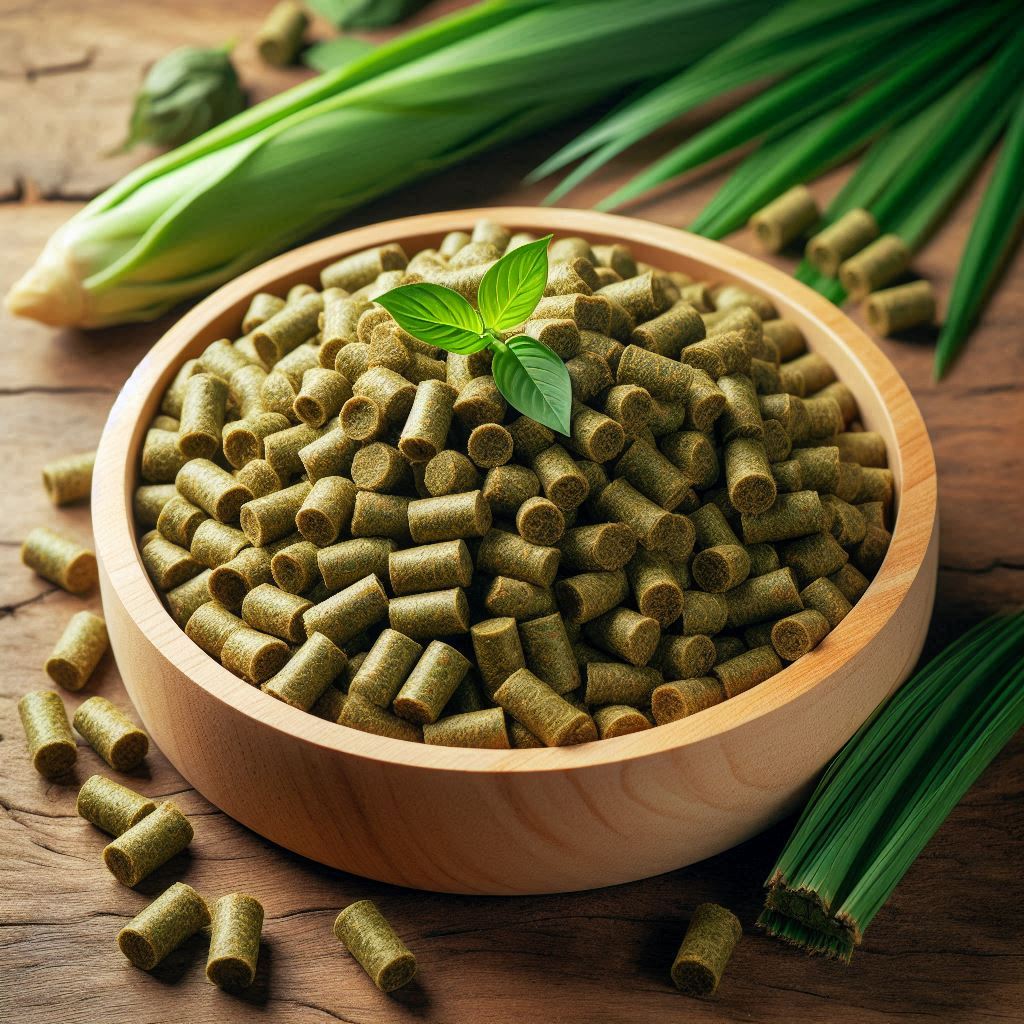
How can Napier Grass be effectively used to create nutritious feed pellets for livestock, ensuring balanced nutrition and optimal feed quality?
Napier Grass Feed Pellet Recipe
Ingredients (per 100 kg batch):
- Napier Grass (dried and ground) – 50 kg
- Rich in fiber and energy, forms the base of the pellet.
- Maize/Corn Meal – 20 kg
- High in energy, enhances palatability and overall energy content.
- Soybean Meal – 15 kg
- Provides high-quality protein, crucial for animal growth, lactation, and health.
- Wheat Bran – 10 kg
- Adds fiber, moderate protein, and helps bind the ingredients.
- Molasses – 3 kg
- Improves taste and provides extra energy; acts as a natural binder.
- Mineral Premix – 1 kg
- Supplies essential vitamins and minerals, such as calcium, phosphorus, and vitamins A, D, and E.
- Salt – 1 kg
- Enhances feed intake and balances electrolytes.

Instructions for Pellet Mill Processing:
- Preparation:
- Ensure the Napier grass is chopped and dried to approximately 15% moisture content. Grind it into a fine, consistent particle size.
- All other dry ingredients should also be ground to a uniform size.
- Mixing:
- In a mixer, combine all dry ingredients (Napier grass, maize meal, soybean meal, wheat bran, mineral premix, and salt) to ensure even distribution.
- Gradually add molasses while mixing to coat all ingredients thoroughly. Avoid making the mixture too wet; aim for a crumbly, evenly coated texture.
- Pelleting:
- Feed the prepared mixture into a pellet mill using an appropriate die size:
- Cattle Feed: 6-8 mm die.
- Goats and Sheep: 4-6 mm die.
- Young Livestock: 3-4 mm die.
- Adjust the temperature and pressure settings as per the pellet mill’s manual to achieve optimal binding, ensuring pellets have the right density and durability.
- After extrusion, allow the pellets to cool and dry until they reach a stable moisture content of around 10-12%.
- Feed the prepared mixture into a pellet mill using an appropriate die size:
- Storage:
- Store the finished pellets in a cool, dry area. Ideally, the pellets should be used within 2-3 months to maintain nutritional quality and avoid mold growth.
Nutritional Analysis (Approximate):
- Crude Protein: 12-14%
- Crude Fiber: 20-25%
- Energy: 2200-2500 kcal/kg
- Calcium and Phosphorus: Balanced for livestock nutritional needs
Mineral Premix Composition (1 kg per 100 kg batch): The mineral premix plays a key role in maintaining the health, productivity, and overall well-being of livestock. It typically includes:
- Calcium and Phosphorus:
- Supports bone strength, milk production, and metabolic functions.
- Salt (Sodium and Chloride):
- Improves feed palatability, nutrient absorption, and electrolyte balance.
- Magnesium:
- Necessary for enzyme functions, nerve transmission, and muscle relaxation.
- Trace Minerals (Copper, Zinc, Manganese, Iron, Iodine):
- Important for immune health, reproductive functions, enzyme production, and skin/fur quality.
- Vitamins A, D, and E:
- Vitamin A: Enhances vision, skin health, and immunity.
- Vitamin D: Promotes calcium and phosphorus absorption, vital for bone health.
- Vitamin E: An antioxidant that supports muscle health and immunity.
Including this premix helps ensure balanced nutrition, preventing deficiencies and promoting growth, productivity, and animal health.
Recommended Pellet Size for Different Animals:
- Cattle (Adult): 6-8 mm diameter
- Larger pellets are easier for adult cattle to consume and aid in rumination.
- Goats and Sheep: 4-6 mm diameter
- Medium-sized pellets are suitable for easy consumption and digestion by small ruminants.
- Young Livestock (Calves, Kids): 3-4 mm diameter
- Smaller pellets are appropriate for young animals with smaller mouths and underdeveloped digestive systems.
- Poultry: 2-3 mm diameter
- Small pellets work best for chickens, especially young birds.
- Fish and Aquaculture: 1-2 mm diameter for fingerlings, 3-4 mm for adult fish
- Pellet size should be easy for aquatic animals to consume without disintegration.
These pellet sizes can be customized based on the target animal, feed machinery, and specific nutritional requirements.
Supporting Resources for Formulation and Processing:
- Scientific Studies and Guidelines:
- FAO Feed Formulation Guides: Provides resources on formulating feed, especially for tropical forage like Napier grass.
- Livestock Nutritional Requirements: Consult research such as NRC guidelines to ensure protein and mineral premix meet the specific needs of different animals.
- Analytical Testing Reports:
- Nutritional Analysis: Lab testing can verify crude protein, fiber, and mineral levels in Napier grass to ensure balanced nutrition.
- Pellet Durability and Density Tests: Conducting these tests helps ensure that pellets are strong enough for storage and transport.
- Premix Composition Standards:
- IS or ISO Certifications: Use premixes certified by relevant standards to guarantee quality.
- Veterinary Supplements: Refer to datasheets for accurate vitamin and mineral content in premixes.
- Machinery Manuals:
- Pellet Mill Operating Guide: Follow the manufacturer’s guidelines for optimal temperature, pressure, and feed rate to achieve the best pellet quality.
- Mixing and Drying Equipment Documentation: Proper use of equipment enhances pellet homogeneity and stability.
- Expert Recommendations and Case Studies:
- Feed Consultant Advice: Consulting a nutritionist helps fine-tune the mineral premix and ingredient ratios based on livestock type and feed ingredient availability.
- Case Studies: Learn from real-world experiences of Napier grass utilization in animal feed to refine feed formulation.
These resources ensure that feed pellets are nutritionally balanced, effective, and provide the necessary vitamins and minerals to promote the health and productivity of livestock.
Note: This recipe is adaptable to specific livestock needs, available ingredients, and target nutrition levels. Always adjust based on laboratory results, livestock requirements, and expert advice for optimal feed quality.
Contact Us for More Information

Servoday Plants & Equipments Limited
Phone: +91 9427210483
Email: [email protected]
Web: www.PelletIndia.com, www.GrabsIndia.com